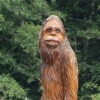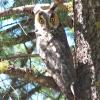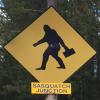Leaderboard
Popular Content
Showing content with the highest reputation on 07/07/2016 in all areas
-
I agree and I think the sign of passage is there, the question is whether or not there is an observer, whether or not the observer sees the sign, and whether or not the observer correctly identifies who/what left it. I think there is a lot more out there to see than is seen, noticed, and properly identified. In favor of not being noticed are specific diet and eating habits regarding plants, the careful and quiet movement of an apex predator not wishing to scare off potential animal protein thus NOT imitating a drunk sherman tank crashing through a field of corn flakes, and things like that. Existence of critters like bears that share territory and food sources obfuscates the evidence left as well as providing a rational (and probably most often correct) counter-explanation for what evidence is left. I believe you've often said that bigfoot should not be our first assumption. No disagreement, just noticing that overlooking some amount of legitimate bigfoot "sign" is probably a necessary consequence of that. My suspicion (or rationalization) here is that unless you get into a core area used by some bigfoots for some extended amount of time, there probably won't be enough evidence to for it to be remarkable enough for human notice .. maybe with the exception of the person who is specifically looking for them rather than engaging in some other activity and merely stumbling past (rather than on :)) that evidence. I think you're more likely to have some sort of bigfoot activity like knocks or howls to bring bigfoot to your immediate attention, then notice the sign that has been all around you already than you are to notice the sign "unprovoked". Guesses. Hopefully educated, but definitely guesses. MIB2 points
-
I don't think the comparison is valid. Two reasons come to mind. First, with regard to signs made by passage, not feeding, if the gorilla pictures online accurately depict typical habitat, it would be pretty difficult to move through such "cover" without damaging plants. However, this isn't the case for the cover found in most of North America. I can move fine through a conifer forest (where I've had most of my interactions), oak savannah, and most other plant communities other than some thickets of stuff I'd just go around, without leaving a visible trail. If I can, they can. Second, with regard to signs from feeding, gorillas are essentially 100% herbivore, however, according to the evidence, bigfoots are not, they are omnivores. Gorillas seem to eat pretty much leafy green stuff. Bigfoots seem not to, their plant material tends to be berries, mushrooms, tubers, and the like. There isn't much evidence suggesting the walk along munching handfuls of leaves torn off trees in a way that would create a trail that you can find. So .. interesting idea on the surface, just don't think about it very hard. If you do, why it is wrong becomes painfully obvious. MIB2 points
-
So, I'll have to answer my own question, although Bodhi I'm sure could just as well. The question being: What should a field researcher like Utah Sasquatch do with all of this presumed data, video and genetic information he might possibly capture? Pound sand, that's what. U.S. knows now, if he didn't know before, that there is no legitimized outlet, no sanctioned scientific entity or agency that would return his calls. Toss the information into the black hole of the internet? Congratulations on your thousands of views. Here's a copy of the home game and thanks for playing. (Oh, and kiss that shot at tenure and funding goodbye while you are at it, and grow some thicker skin) Time and again the evidence collected gets dismissed by a wave of the hand by people who should know better. Being invited to kick the football one more time while they promise (really) to hold it for you? Pffft. So all we have going on with our resident peanut gallery hecklers here is just the most recent cross-my-heart-and-hope-to-die-stick-a-needle-in-my-eye request. No. Really. This time I'll give you your due. (But just sayin' too, if I do renege, it will probably be your fault, not mine, 'k?) Ready? So to crib from another thread: Here is the state of Sasquatch Science. Supposedly, we are told, only the body of something very few people are looking for is going to break this logjam. Those who clamor for that outcome are asking for something they've never seriously considered to exist, and cite the lack of any other legitimate evidence brought to any sanctioned authority,,,those shown to be hostile to that lesser evidence... as the reason why. They pretend this makes perfect sense.2 points
-
Very astute observation MIB. As I've said before bears are a very good indicator species for bigfoot. The biggest problem is differentiation between bear feeding behavior and what might possibly be bigfoot. The problem being that most of what bears do can't really be separated from what something with similar behavior would do. Such as ripping up stumps, rolling logs, flipping rocks or digging roots. That's one reason, as SWWSP mentioned, I've presented another facet of feeding behavior that is different from what bears do. It doesn't require a PhD to figure out. Just good observational skills. Bears and canids destroy and scatter bones from animals that they feed on. If you find a pretty much intact skeleton it was probably a cougar that feed on it. Even after natural decay processes this is apparent. If the ribs are close to their natural position even after decay then you probably have a cougar feeding site. However, if the ribs are removed from the vertebrae, are still intact and placed separately from them you have to ask what predator/scavenger did this. You don't have to be a dental expert. You don't even have to look that closely at the bones. Although to determine which animals were doing what, I did do those things on over two dozen feeding sites now. Out of those sites six exhibited the behavior I mentioned to look for above. Incorrigible is right. If bigfoot exists there should be evidence of their presence. The problem comes, as MIB says, in finding it, then recognizing what you have found.1 point
-
You seem to be ignoring the bone stack evidence for elk predation that BTW is investigating. How many kills are wrongly attributed to cougars? I find deer kills that do not exhibit the movement, scatter and dismemberment associated with wolves, coyotes, and cougars. Ever watched a video of a wolfpack tear apart a deer or elk? The most puzzling finds of mine are relatively intact deer kills, with pretty much the entire carcass present, but the head is missing. What animal does that? As far as berries, fruit, etc and a swath left behind, could it be that a omnivore with hands might not make such a mess as a bear. A bear in a camp is very messy. Bears do not care of they make a mess eating, tear stuff apart, leave footprints, even though they too avoid humans. They are not smart enough to know that such damage reveals their presence. You do not see much of a mess left by humans in a self pick berry field even though most humans are pretty much slobs. And finally, from my own experience with footprint finds, BF goes out of its way to avoid leaving footprint evidence it has been present even in remote areas. Avoiding muddy trails by stepping across them, not using human trails, and using patches of vegetation to step on in soft areas. Why would we not expect the same care from BF as far as food procurement and leaving behind evidence they have been present? If their intelligence approaches humans as some suspect, they might even pin their predation on some other animal by mimicking that animals predation behavior as far as disposition of the carcass.1 point
-
The ones I saw were in Colorado near the town of Ridgeway. I don't think that is considered bear country. Despite that, when I saw them I did spend some time looking at their heads which I could see in side profile. There was no snout- that was the first thing that really caused me to think I was seeing something weird. Actually I think it might have been more frightening if they really were bears because if that is what they were, then bears in the lower 48 can get a lot larger than anyone had any idea!1 point
-
You can't win that one even if you were right, the closest you could get is not losing yet. Can't prove negative existence, you can only prove you didn't find anything. Equating the two requires invalid logic. If I were going to take that bet I'd play lawyer and find some way to word it so that I could win. The thought behind your choice certainly is a thing we all should ponder in own ways. I know they're there, I've seen what I've seen. So how, and why, and all that, do we not have proof? I'm not deliberately heading for the rabbit hole but if the tracks lead there I will follow. Real science doesn't refuse to examine uncomfortable evidence. But .. yeah .. how (not), and why (not) ... (yet) ... that's a real puzzle. Somewhere, somehow, our assumptions, maybe assumptions we aren't aware of making, are misleading us causing us to look in the wrong place, not notice something obvious ... or something. We need to get a better grasp of all the things we assume and recheck their validity. I think 'til we do that, we're going to stay stuck with no further progress. MIB1 point
-
DWA: "I know. No rational person bets that one either. All one needs to do to get to the rational presumption that these animals are authentic...is approach it objectively." The difference between skeptics and those proponents who are either witnesses or had "it could only have been BF" encounters is location, luck and time spent in the field. I do not get the impression from any skeptic here on the forum that they have spent significant time in the field in a region where BF are at all common. One can see where they could come to the conclusion that nothing is there to see where they live, but that does not mean that applies to the whole country. In the PNW sightings are so common that if you ask around, you will frequently find someone that has had a sighting or knows someone that has. I do not think that happens in most parts of the country where sightings are very rare. It is a whole lot easier here to be open to the possibility of existence.1 point
-
P-G: Not bothered at all. They use many of the same food sources so of course they SHOULD be found in the same places. Considering them from a biological standpoint, I would be more bothered if it were otherwise. I know bears. I grew up in a bear preserve. We'd see up to a dozen a day. At certain times of year we had a lot of problems with them getting into fruit trees, garden, and trash cans as well as our boats which sometimes smelled of the fish we caught. When I was guiding with customers bears were a regular thing. I understand bear anatomy, physical proportions, size, behavior ... What I saw was no bear. Not the first, not the second, and not even the "maybe" because whatever it was, it had broad shoulders to the side of the torso, not arranged under it to carry (I almost said "bear" ) weight. MIB1 point
-
You know if you dug in and helped the community research and solve the problem in the field instead of just beating up on them all the time the subject may progress faster and more to your own satisfaction. You'd waste less time and get better results as an ally in getting to the concrete bottom of things than jumping onto threads and calling members wrong all the time. Sometimes you get more bees with honey. But if you only care about the debate and the smugness in that no one can prove you wrong then it will continue to be a sad state of affairs for both sides. Where's the enjoyment in that?1 point
-
Thank you John, for near a lifetime of work. For sharing and for your time. Was saddened to hear the news...for about two seconds...then I smiled. I am glad you are back where you belong my friend...with June. (Pic is of a pic...from Dec 3rd,'05, after lunch with the Greens and company in Harrison Hot Springs, was a good day !) Thank you John ! Pat...1 point
This leaderboard is set to New York/GMT-05:00






